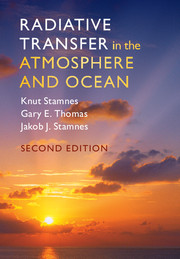Book contents
- Frontmatter
- Contents
- List of Illustrations
- List of Tables
- 1 Basic Properties of Radiation, Atmospheres, and Oceans
- 2 Basic State Variables and the Radiative Transfer Equation
- 3 Basic Scattering Processes
- 4 Absorption by Solid, Aqueous, and Gaseous Media
- 5 Principles of Radiative Transfer
- 6 Formulation of Radiative Transfer Problems
- 7 Approximate Solutions of Prototype Problems
- 8 The Role of Radiation in Climate
- 9 Accurate Numerical Solutions of Prototype Problems
- 10 Shortwave Radiative Transfer in the Atmosphere and Ocean
- Appendix A Nomenclature: Glossary of Symbols
- Appendix B Physical Constants
- Appendix C Ocean Optics Nomenclature
- Appendix D Reflectance and Transmittance at an Interface
- References
- Index
10 - Shortwave Radiative Transfer in the Atmosphere and Ocean
Published online by Cambridge University Press: 13 July 2017
- Frontmatter
- Contents
- List of Illustrations
- List of Tables
- 1 Basic Properties of Radiation, Atmospheres, and Oceans
- 2 Basic State Variables and the Radiative Transfer Equation
- 3 Basic Scattering Processes
- 4 Absorption by Solid, Aqueous, and Gaseous Media
- 5 Principles of Radiative Transfer
- 6 Formulation of Radiative Transfer Problems
- 7 Approximate Solutions of Prototype Problems
- 8 The Role of Radiation in Climate
- 9 Accurate Numerical Solutions of Prototype Problems
- 10 Shortwave Radiative Transfer in the Atmosphere and Ocean
- Appendix A Nomenclature: Glossary of Symbols
- Appendix B Physical Constants
- Appendix C Ocean Optics Nomenclature
- Appendix D Reflectance and Transmittance at an Interface
- References
- Index
Summary
Introduction
Two problems in atmospheric and environmental science have received much attention: the occurrence of widespread ozone depletion and global warming. Ozone depletion has been related directly to the release of man-made trace gases, notably chlorofluorocarbons used in the refrigeration industry and as “propellants” in spray cans. Since ozone provides an effective shield against damaging ultraviolet radiation from the Sun, there is indeed good reason to be concerned, because a thinning of the ozone layer has serious biological ramifications. The most harmful ultraviolet (UV) radiation reaching the Earth's surface, commonly referred as UV-B radiation, lies in the wavelength range between 280 and 320 nm (see Table 1.1). UV-B radiation, which has enough energy to damage the DNA molecule, is strongly absorbed by ozone. Radiation with wavelengths between 320 and 400 nm, referred to as UVA radiation, is relatively little affected by ozone. UV-A radiation can mitigate some of the damage inflicted by UV-B radiation (a phenomenon known as photo-repair), but it causes sunburn and is therefore believed to be a partial cause of skin cancer. In addition to the harmful effects on humans, too much UV radiation has deleterious effects on terrestrial animals and plants, as well as aquatic life forms.
Ozone is a trace gas, whose bulk content resides in the stratosphere. Its abundance is determined by a balance between production and loss processes. Chemical reactions as well as photolysis are responsible for the destruction of atmospheric ozone. Its formation in the stratosphere relies on the availability of atomic oxygen, which is produced by photodissociation of molecular oxygen. Ozone is then formed when an oxygen atom (O) and an oxygen molecule (O2) combine to yield O3. It is produced mainly high in the atmosphere at low latitudes where light is abundant, and subsequently transported to higher latitudes by the equator-to-pole circulation (Brasseur and Solomon, 2006). Thus, the distribution of ozone in the atmosphere, vertically and globally, is a result of a subtle interplay between radiation, chemistry, and dynamics.
Ozone absorbs ultraviolet/visible radiation as well as thermal infrared (terrestrial) radiation in the 9.6 μm band. A thinning of the ozone layer renders the stratosphere more transparent in the 9.6 μm region, thereby allowing more transmission, and less surface backwarming.
- Type
- Chapter
- Information
- Radiative Transfer in the Atmosphere and Ocean , pp. 389 - 472Publisher: Cambridge University PressPrint publication year: 2017



